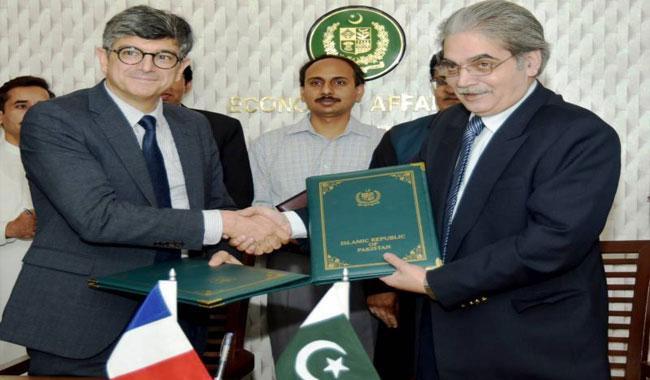fatman17
PDF THINK TANK: CONSULTANT

- Joined
- Apr 24, 2007
- Messages
- 32,563
- Reaction score
- 98
- Country
- Location
Canadian Commercial Corporation Will Build Another 1 Gigawatt Of Solar In Pakistan
March 1st, 2017 by Saurabh Mahapatra
Originally published on CleanTechies.
Pakistan got a much needed boost for its power sector when, recently, a Canadian government entity announced plans to set up large-scale solar power projects in the South Asian country.
The Canadian Commercial Corporation signed a memorandum of understanding with the government of Khyber Pakhtunkhwa province of Pakistan to set up 1,000 megawatts of solar power capacity. The capacity is expected to be installed over a period of three years, but size and location within the province has not yet been disclosed.
Second such agreement with Canada
This is possibly the second such agreement signed by the Canadian government to set up solar power projects in Pakistan. Last year, Canada signed an agreement with the government of Balochistan province to set up 1,000 megawatts of solar capacity. As per the agreement, a Canadian company will set up 20 solar power projects of 50 MW of capacity each. The projects are expected to be distributed across the province.
Pakistan: A suitable market for solar
Pakistan is the perfect location for setting up solar power projects. The company has vast swaths of land to host large-scale solar power projects. The power demand-supply situation in Pakistan has been poor for several years and the country has been marred with frequent and long power outages. The power sector is overwhelmingly dependent on furnace oil and hydro projects for power generation; the former is costly while the latter is highly dependent on rainfall.
Pakistan currently faces a shortfall of around 6,000 megawatts. It has been forced to import electricity from neighboring Iran. The volume of import from Iran stands at 100 megawatts, but Pakistan plans to increase it to 3,000 megawatts.
Attractive tariffs for developers
A number of foreign project developers are looking to invest in Pakistan due to the attractive feed-in tariffs offered by the government. The country is yet to shift to competitive auctions, like many developing countries have.
In late 2015, Pakistan’s National Electric Power Regulatory Authority (NEPRA) announced a 25% reduction in solar feed-in tariffs. Even at these reduced tariffs the developers of these projects are expected to get around 11.0/kWh. In neighboring India, however, tariffs discovered through competitive auction have fallen to 6.5¢/kWh, and more recently to 4.9¢/kWh.
Reprinted with permission.
March 1st, 2017 by Saurabh Mahapatra
Originally published on CleanTechies.
Pakistan got a much needed boost for its power sector when, recently, a Canadian government entity announced plans to set up large-scale solar power projects in the South Asian country.
The Canadian Commercial Corporation signed a memorandum of understanding with the government of Khyber Pakhtunkhwa province of Pakistan to set up 1,000 megawatts of solar power capacity. The capacity is expected to be installed over a period of three years, but size and location within the province has not yet been disclosed.
Second such agreement with Canada
This is possibly the second such agreement signed by the Canadian government to set up solar power projects in Pakistan. Last year, Canada signed an agreement with the government of Balochistan province to set up 1,000 megawatts of solar capacity. As per the agreement, a Canadian company will set up 20 solar power projects of 50 MW of capacity each. The projects are expected to be distributed across the province.
Pakistan: A suitable market for solar
Pakistan is the perfect location for setting up solar power projects. The company has vast swaths of land to host large-scale solar power projects. The power demand-supply situation in Pakistan has been poor for several years and the country has been marred with frequent and long power outages. The power sector is overwhelmingly dependent on furnace oil and hydro projects for power generation; the former is costly while the latter is highly dependent on rainfall.
Pakistan currently faces a shortfall of around 6,000 megawatts. It has been forced to import electricity from neighboring Iran. The volume of import from Iran stands at 100 megawatts, but Pakistan plans to increase it to 3,000 megawatts.
Attractive tariffs for developers
A number of foreign project developers are looking to invest in Pakistan due to the attractive feed-in tariffs offered by the government. The country is yet to shift to competitive auctions, like many developing countries have.
In late 2015, Pakistan’s National Electric Power Regulatory Authority (NEPRA) announced a 25% reduction in solar feed-in tariffs. Even at these reduced tariffs the developers of these projects are expected to get around 11.0/kWh. In neighboring India, however, tariffs discovered through competitive auction have fallen to 6.5¢/kWh, and more recently to 4.9¢/kWh.
Reprinted with permission.








